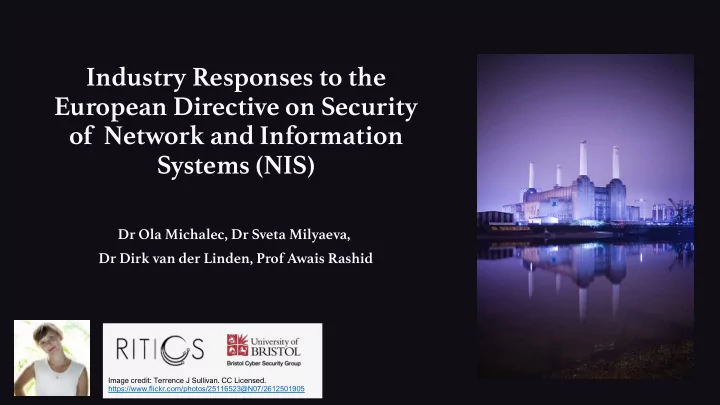

Industry Responses to the European Directive on Security of Network and Information Systems (NIS) Dr Ola Michalec, Dr Sveta Milyaeva, Dr Dirk van der Linden, Prof Awais Rashid Image credit: Terrence J Sullivan. CC Licensed. https://www.flickr.com/photos/25116523@N07/2612501905
Background • Operational Technologies (OT): engineering equipment used in critical infrastructure sectors (e.g. water, energy, transport). Traditionally built for safety and resilience • Now OT are becoming digitised and connected to the Internet. This creates new avenues for cyber security attacks: blackouts in power stations, pollution of water supply, hacked traffic signals. • The Network and Information Systems Security (NIS) directive aims to improve the baseline level of security across critical infrastructures. Since 2018, the European Union member states and the UK have been working on implementing it. • Many questions arising: How to define the scope of the policy? How will NIS impact digital innovation? How to evidence OT are ‘secure enough’? How to ensure NIS won’t become a tick-box exercise?
Research questions 1. How is the knowledge of OT security created? 2. How do CNI operators interpret and implement cyber security regulations? Research design Semi-structured interviews with 30 cyber security professionals in CNIs, consultancies, law firms, public sector (October 2019-January 2020)
Findings: how OT security expertise is created 1 . Critical infrastructure operators face two converging challenges: • An increasing pressure to recruit Operational Technology (OT) experts: practitioners skilled in both engineering and computer sciences. • The quality and expertise of OT professionals is inconsistent due to the varied routes into the career. Without recognised qualifications, employers face a challenge to identify capable candidates. 2 . We risk that poorly evidenced and Operational Technology-inappropriate advice will be circulated to influence key security decisions. We explore this risk by introducing the concept of ‘security tropes’. 3 . Filling the “skills gap” is more than a matter of supply and demand in OT security niche alone. As NIS pertains to services essential to the society, it requires attention to public values.
Findings: OT security tropes (example) Trope: IIoT is inevitable Analysis: The discourse of "inevitability" of innovation is consciously perpetuated by the IIoT manufacturers. CNI operators and regulators play an active role in deciding on the future of IIoT and other innovative technologies. Risk to NIS: Regulations becoming a vehicle for implementing IIoT for its own sake, without concerning security and other public values. NIS Recommendations for regulators: align the timescales of innovation funding, regular upgrades and NIS improvement plans. Seek robust evidence for the claims on the operational benefits of IIoT before approving funding.
Key messages 1. NIS requires to reconsider how OT security expertise is formed: who are the experts? What makes someone an expert? What if they disagree? 2. The pressure to implement security solutions combined with a sector- wide skills gap creates a fertile ground for developing security tropes. 3. The implementation of technical policies and standards is a two-way exchange: we need to pay attention to the debates and negotiation taking place before key decisions are made.
Teaser: Four types of NIS implementation practices Compliance Workaround Going above and beyond Negotiation policy remit Security Completing asset OT experts Intelligence sharing Operators giving feedback Example discovery as an essential implementing their through a working group to regulators: asking to basis for further cyber own security set based on trust and improve IT security-biased improvements measures, using shared terms of reference language of policy policy as a “sanity documents check” Insecurity Interpreting the scope of Senior executives Overreliance on the latest Prioritizing business values example NIS to own advantage, ignoring the need for ‘buzzword’ technologies over public values in policy while excluding key OT improvements, based when basic knowledge interpretation (considering assets on their own about them is missing securing assets at the interpretations of expense of customers’ ‘appropriate and privacy) proportionate’ clause in NIS * Please see our full paper for more details!
Recommended reading: Frey, S., Rashid, A., Zanutto, A., Busby, J. and Follis, K. (2016) On the Role of Latent Design Conditions in Cyber-Physical Systems Security. 2 nd International Workshop on Software Engineering for Cyber Physical Systems Hallet, J., Larson, R. and Rashid, A. (2018) Mirror, Mirror, On the Wall: What are we Teaching Them All? Characterising the Focus of Cybersecurity Curricular Frameworks. USENIX Workshop on Advances in Security Education. Rashid, A., Gardiner, J., Green, B. and Craggs, B (2019) Everything is Awesome! Or is it? Cyber Security Risks in Critical Infrastructure, CRITIS Slayton, R. and Ginsberg, A. (2018) Beyond regulatory capture: Coproducing expertise for critical infrastructure protection. Regulation and Governance . 12 (1), pp. 115-130
Thank you for your attention. Any questions? Email: ola.michalec@bristol.ac.uk
Recommend
More recommend